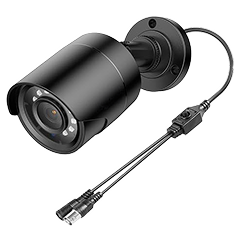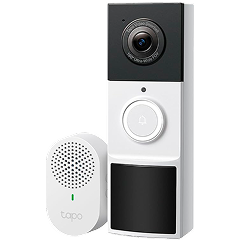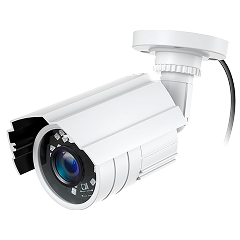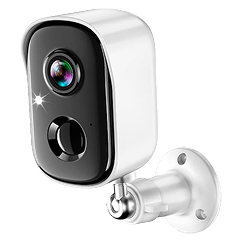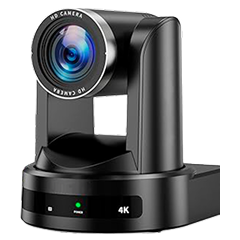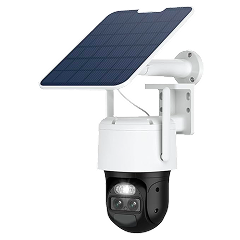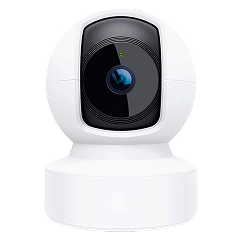Hace cinco años, empecé a usar un timbre básico de la marca Ring al igual que millones de propietarios. Lo que empezó siendo una solución sencilla para vigilar las entregas de paquetería me llevó a instalar tres cámaras Ring en mi propiedad y a sumergirme de lleno en el mundo de la tecnología de vigilancia.
Como todo buen ingeniero suelo abordar los problemas de forma sistemática y la cuestión de mantener segura mi casa no fue una excepción. Total, que acabé midiendo los ángulos de las cámaras, probando hasta qué punto funcionaba realmente la visión nocturna y calculando cuánto ancho de banda necesitaba para que todo funcionara correctamente. También llegué a la conclusión de que las cámaras de uso genérico tienen más límites de los que parece.
Las cámaras Ring me enseñaron que una cosa es lo que anuncian las empresas en sus campañas de marketing, pero otra muy diferente es la realidad. Sin duda, son fáciles de instalar, pero tienen algunos problemas que no se mencionan en la descripción del producto.
Se va Internet y las cámaras dejan de grabar, así que si quieres que sus prestaciones sean lo suficientemente buenas lo mejor es que pagues una suscripción mensual. Por otro lado, si lo que buscas es una mayor personalización, tal vez deberías buscar otra opción. Todo esto fue lo que me empujó a investigar sobre los sistemas Ubiquiti. Cuando construí mi casa, trabajé con el constructor para que el Ethernet llegara a lugares estratégicos y así poder instalar un sistema de cámaras UniFi.
Toda esta experiencia me ayudó a comprender que el “mejor” sistema de vigilancia es el que se adapta a tus necesidades, nivel de conocimientos técnicos y objetivos a largo plazo.
Comprende primero tus necesidades de seguridad
Antes de llegar a la resolución 4K o a las funciones de detección de IA, debes tener claro qué es lo que quieres proteger y por qué. Mi primera cámara Ring parecía estar perfectamente colocada hasta que revisé las imágenes y me di cuenta de que estaba grabando el camino de entrada de mi vecino, pero no grababa la zona por la que la gente se acercaba a la puerta de mi casa.
Podría parecer descabellado, pero lo mejor es recorrer tu propiedad con un cuaderno y tomar nota de cada puerta, ventana, valla y acera por donde podría colarse alguien sin ser visto. Marca las zonas más importantes, como garajes, casetas y elementos de exterior de valor.
El mayor error que comete la gente es comprar las cámaras primero y dejar la planificación para después. La problemática a la que te enfrentas es lo que determina todo lo demás: ¿te preocupa que te roben los paquetes, que entren en tu propiedad o el vandalismo? ¿Quieres disuadir a los delincuentes de forma visible o prefieres algo más discreto? Estas preguntas son indispensables para determinar tu objetivo, así que te recomiendo planificar la instalación del servicio de la siguiente manera:
- Haz un mapa de los puntos de acceso vulnerables: todas las ventanas, puertas, verjas y caminos por los que alguien podría colarse sin ser visto.
- Identifica las zonas donde guardas cosas de valor: garajes, cobertizos de almacenamiento, equipos costosos y otras áreas principales.
- Calcula el coste total: no te olvides de incluir el precio de las suscripciones mensuales, las actualizaciones de almacenamiento y las futuras cámaras (el coste de la suscripción de Ring me sorprendió).
- Prioriza la cobertura interior a la exterior: las cámaras de exterior necesitan resistencia a la intemperie y mayor visión nocturna; en las de interior lo más importante es la resolución del vídeo y la calidad de audio
- Decide el estilo de vigilancia que quieres: piensa en si vas a vigilar activamente los vídeos, revisar las grabaciones después de los incidentes o ambas cosas. Esto influirá en el número de cámaras que necesitas.
Especificaciones técnicas más importantes
Cuando tengas claro cuál es el sistema de cámaras de seguridad que quieres, podrás empezar a adentrarte en las especificaciones y características que necesitas.
Resolución del vídeo: indispensable para conseguir una grabación útil
Solía pensar que la resolución 1080p era suficiente hasta que intenté identificar a una persona desconocida en la puerta de mi casa con las grabaciones de mi cámara Ring. La sorpresa fue que esa supuesta “alta definición” se convirtió en un borrón pasados los 7 metros de distancia.
Hoy en día, las cámaras 4K no tienen un precio mucho mayor a las de 1080p, por lo que merece la pena pagar la diferencia. Una cámara 4k puede ayudarte a identificar fácilmente a intrusos y delincuentes en tu propiedad, más que una cámara de 1080p.
Lo cierto es que el timbre Ring graba vídeos decentes a 1080p, pero en muchos casos la cara de la persona puede estar tan borrosa que impide identificarla si está demasiado lejos (más de 6 metros), una mayor resolución te ayuda a capturar pruebas mejores. La calidad 1080p va bien cuando solo quieres comprobar si hay alguien en casa o necesitas localizar a tus mascotas, pero cualquier cámara que pueda grabar un delito debe tener calidad 4K para captar los detalles que importan. También debes tener en cuenta que los archivos 4K ocupan mucho espacio de almacenamiento.
Rendimiento y alcance de la visión nocturna
Las especificaciones de la cámara Ring dicen que la visión nocturna tiene alcance de 9 metros, pero en mi jardín este alcance se reduce a unos 6 metros en una noche iluminada para ser de utilidad. Las luces de la calle ayudan, pero las sombras de los árboles o los edificios crean puntos muertos a los que no llegan bien los infrarrojos.
Esta lección la aprendí a las malas cuando revisé las imágenes de alguien que merodeaba por delante de mi garaje a las 2 de la madrugada, veía movimiento, pero no pude identificar nada.
Las condiciones meteorológicas también merman el rendimiento de la visión nocturna más de lo que les gustaría admitir a los fabricantes. La humedad puede dispersar la luz infrarroja y empañar la calidad de la imagen. De hecho, mis cámaras funcionan peor durante los meses de verano, cuando los niveles de humedad son altos.
Si necesitas vigilar zonas muy amplias, como entradas de vehículos o patios traseros, lo mejor es invertir más dinero en cámaras con una visión nocturna de más de 30 metros. La diferencia entre una cámara con alcance de 9 metros y una de 30 metros, suele ser determinante a la hora de ver lo que ocurre en los límites de tu propiedad, que es donde suelen empezar los problemas.
Resistencia a la intemperie
La clasificación IP se traduce directamente en la longevidad de la cámara en exteriores. IP65 significa protección contra el polvo y el agua; IP67 soporta una inmersión temporal, esta diferencia es mucho más importante de lo que parece. Las cámaras Ring con clasificación IP65 mostraron signos de que la humedad había entrado en el dispositivo tras dos años en el clima del Medio Oeste, mientras que las cámaras con clasificación IP67 en posiciones similares estaban impolutas.
Las temperaturas extremas no solo afectan al funcionamiento, sino que los componentes se degradan más rápidamente en ciclos extremos de calor o frío. A la hora de planificar la ubicación de las cámaras, no solo hay que tener en cuenta el clima, sino también la radiación térmica de las superficies cercanas, las heladas matinales y la exposición al sol a lo largo del día. Por ejemplo, montar las cámaras debajo de los aleros en lugar de exponerlas directamente puede duplicar su vida útil.
Campo de visión y optimización del alcance
Para planificar el alcance de las cámaras de seguridad, hay que realizar mediciones y hacer cálculos reales, no conjeturas. Una cámara de 90 grados situada a 6 metros de la zona objetivo cubre unos 10 metros de ancho, mientras que una cámara de 130 grados cubre unos 15 metros. No obstante, más anchura no siempre es mejor, ya que se pierde detalle del área de cobertura.
Hice un mapa del alcance de las cámaras en mi propiedad con un sencillo cálculo matemático, descubrí que al colocar estratégicamente tres cámaras de 110 grados obtenía un mayor alcance que si usaba cuatro cámaras de 90 grados. Esta es la razón por la que conocer las zonas de solapamiento y los puntos muertos es algo fundamental. Lo más eficaz en cuanto a alcance suele ser instalar las cámaras en las esquinas, pero plantea ciertos problemas de montaje y exposición a la intemperie.
Detección de movimiento y funciones de IA
Una detección de movimiento básica se activa con cualquier cosa: ramas que se mecen, coches que pasan, gatos del vecindario. Las cámaras Ring generaban gran cantidad de alertas falsas a diario hasta que aprendí a configurar correctamente las zonas de detección. En mi experiencia, la detección moderna con IA que distingue entre personas, vehículos y animales reduce las alertas falsas en un 80-90 %.
La utilidad de las funciones de IA dependerá de tus necesidades específicas. Por ejemplo, los paquetes de detección funcionan bien para las cámaras de las puertas principales, pero no son tan útiles para vigilar perímetros. Además, el reconocimiento facial necesita una buena iluminación y ángulos de cámara adecuados. Por otro lado, las funciones de análisis de comportamiento que detectan gente merodeando o patrones de movimiento inusuales tienen muy buena pinta, pero de momento no son demasiado útiles.
Funciones de audio y grabación
Por lo general, al elegir una cámara no solemos prestar mucha atención a las funciones de audio, pero lo cierto es que son indispensables para captar el contexto que el vídeo por sí solo no capta, así como para permitir interacciones en tiempo real con visitantes o intrusos.
Grabación de audio
Consulta la legislación local antes de activar la grabación de audio, ya que las leyes pueden variar. Cuando estés seguro de que no estás incumpliendo ninguna ley, podrás activar la grabación de audio para añadir contexto a los vídeos de seguridad, ya que las conversaciones, los cristales rotos, los portazos de coches o las pisadas proporcionan información que ayuda a interpretar lo que se ve en vídeo.
El rendimiento del micrófono en exteriores varía mucho según el modelo de la cámara, las cámaras Ring captan el audio con claridad a una distancia de entre 4 y 6 metros, pero presentan problemas con el ruido del viento durante las tormentas. Por otro lado, las cámaras de interior suelen ofrecer una calidad de audio mucho mejor, ya que no están expuestas a las interferencias meteorológicas. La integración con las alertas de seguridad resulta muy útil cuando los activadores de audio pueden distinguir entre sonidos domésticos normales y circunstancias que pongan en riesgo la seguridad de tu hogar.
Comunicación de audio bidireccional
El audio bidireccional transforma las cámaras de vigilancia pasiva en herramientas de seguridad activa. He utilizado el audio bidireccional de mi timbre Ring para darles instrucciones a los repartidores, disuadir a los ladrones de paquetería y comunicarme con mis familiares cuando estoy de viaje. La utilidad disuasoria de esta función justifica por sí sola el uso de dispositivos en las puertas principales de las casas.
Mi timbre Ring funciona bien para dar instrucciones básicas, pero es poco funcional cuando hay viento o ruido de fondo, como el del tráfico. Si quieres un mejor audio bidireccional, compra cámaras con cancelación de ruido y controladores de altavoz adecuados, en lugar de esos altavoces baratos con interferencias. También notarás que hay un ligero retraso al hablar a través de cámaras conectadas a Internet, pero eso no afectará a su uso normal.
Alimentación e instalación
Lo que determina la durabilidad del sistema y su mantenimiento es elegir la potencia y los métodos de instalación adecuados.
Elegir la fuente de alimentación
Las cámaras que funcionan con pilas son más fáciles de instalar, pero dan muchos quebraderos de cabeza en cuanto a su mantenimiento. La publicidad de las cámaras Ring dice que su batería dura 6 meses, pero lo cierto es que hay que cargarlas cada 2-3 meses con patrones de uso normales. También hay que tener en cuenta que el frío reduce el rendimiento de la batería a la mitad y que las cámaras ubicadas en zonas con mucho tráfico donde las grabaciones son frecuentes consumen las baterías aún más rápido. Todos los meses de invierno me veía subiendo escaleras para cambiar las pilas de las cámaras de mi antigua casa.
La alimentación por cable elimina los problemas de mantenimiento y permite una grabación continua sin interrupciones. De hecho, cuando planifiqué la instalación de mi sistema Ubiquiti en mi casa actual, diseñé todo en torno a PoE (Power over Ethernet), POE proporciona energía y datos a través de un único cable.
Si usas baterías, la carga solar va bien para alargar la vida útil en climas moderados, pero no puede grabar de forma continua en condiciones de nubosidad o durante los días cortos de invierno. Si la batería de tu cámara se consume por completo, no podrás capturar los incidentes cuando ocurran. Por ello, recomiendo usar alimentación por cable (POE o alimentación directa) para cualquier instalación permanente.
Tipos y métodos de instalación
Las cámaras wifi pueden parecer muy útiles y sencillas hasta que el Internet falla y se pierde la mitad de la cobertura. Esta lección la aprendí durante una tormenta de verano, cuando mis cámaras Ring inalámbricas se quedaron sin conexión justo cuando más las necesitaba. Incluso las cámaras “inalámbricas” necesitan señales wifi potentes y constantes, ya que transmitir lo que graban varios dispositivos en calidad 4K puede saturar la red doméstica durante las horas de mayor uso.
Si bien instalar cables requiere más trabajo al principio, nunca volverás a preocuparte por la intensidad de la señal o los límites del ancho de banda. La instalación de mi timbre Ring fue sencilla: hice unos cuantos agujeros con un taladro, monté el soporte y conecté los cables del timbre, pero al querer añadir cámaras adicionales había que lidiar con zonas wifi muertas y sufrir las consecuencias de que las grabaciones compitieran con Netflix por el ancho de banda.
Los cables Ethernet que había puesto durante la construcción eliminaron esos dolores de cabeza por completo cuando empecé a usar el sistema UniFi. Si estás construyendo tu casa o haciendo reformas, invierte en instalar cables ahora en lugar de tener que lidiar con las limitaciones inalámbricas más adelante.
Soluciones de almacenamiento y gestión de datos
Las decisiones que tomes en cuanto a almacenamiento afectarán a la durabilidad del sistema, a los costes y a tu capacidad para acceder al material cuando te haga falta de verdad.
Almacenamiento local
El almacenamiento local evita que dependas de una conexión a Internet o de cuotas de suscripción. Por una parte, las tarjetas MicroSD funcionan para cámaras individuales, pero carecen de redundancia y tienen una capacidad limitada. Por otra parte, los sistemas NVR gestionan el almacenamiento con redundancia de varias unidades, pero requieren una configuración técnica y un mantenimiento continuo. Al planificarlo todo con UniFi Protect me centré en el almacenamiento local para que los cortes de Internet no pudieran desactivar la grabación de seguridad.
Los sistemas que utilizan únicamente la nube, como los básicos de Ring, resultan siendo inútiles cuando hay problemas de red, que a menudo coinciden con incidentes de seguridad. El almacenamiento local con copia de seguridad en la nube ofrece la mejor redundancia: acceso inmediato a las grabaciones sin depender de Internet, además de una copia de seguridad externa en caso de incendio o robo. Al utilizar varios tipos de copias de seguridad te proteges de posibles fallos, pero cada capa adicional añade complejidad y costes.
Almacenamiento en la nube y planes
Al principio, la suscripción a Ring me costó 3 $ al mes, pero me aumentó a 10 $ cuando añadí cámaras y empecé a necesitar periodos de retención más largos. El coste total me sorprendió: 120 $ anuales por un almacenamiento básico en la nube era un precio que superaba al de muchas cámaras.
Los planes de almacenamiento gratuitos suelen ofrecer entre 24 y 48 horas de retención, que están bien hasta que te das cuenta de lo difícil que es revisar las grabaciones si tienes algo de prisa.
La privacidad de los datos empieza a ser motivo de preocupación cuando las grabaciones de seguridad se suben a los servidores de la empresa. El hecho de que Ring tenga vínculos con las fuerzas de seguridad y sus políticas de intercambio influyeron en mi decisión a la hora de optar por un sistema de almacenamiento local.
Algunos fabricantes te permiten elegir si quieres servicios en la nube o no, esto te da la posibilidad de elegir un almacenamiento exclusivamente local o enfoques híbridos en función del nivel de comodidad que quieras y de tu presupuesto.
Diseño y forma de la cámara
La forma de la cámara influirá en el montaje, la resistencia a la intemperie y lo bien que la cámara se integra o no con tu propiedad.
Estilos de diseño
Las cámaras cilíndricas destacan por su vigilancia de largo alcance y su evidente valor disuasorio. Su diseño cilíndrico aloja eficazmente lentes más grandes y matrices de infrarrojos, lo que las hace ideales para vigilar perímetros, entradas de vehículos y zonas en las que necesites que tus dispositivos de seguridad sean visibles.
En mi planificación con Ubiquiti he incluido cámaras cilíndricas para las esquinas que necesitan un alcance de visión nocturna de más de 30 metros, un punto a su favor es que su resistencia a la intemperie no se ve comprometida por la carcasa alargada.
Las cámaras domo son ideales para protegerte del vandalismo y ofrecen una vigilancia discreta para interiores o zonas exteriores cubiertas. La carcasa en forma de cúpula impide que se pueda determinar la dirección exacta de su visión, lo cual crea un efecto disuasorio psicológico y son menos llamativas que las cámaras cilíndricas.
Las cámaras tipo torreta combinan la protección domo con un montaje más sencillo, como las cámaras cilíndricas. Por otro lado, las cámaras timbre funcionan muy bien para los puntos de entrada, así como para interactuar con los visitantes, pero solo vigilan eficazmente las zonas más cercanas.
Tipos de cámaras especializadas
Las cámaras con reflector cumplen una doble función cuando se necesita vigilar la seguridad e iluminar mejor una zona. En mi caso, instalé una de estas cámaras en la parte delantera de mi garaje donde la luz es tenue y crea sombras que ocultan la actividad. La desventaja de estas cámaras es su complejidad: básicamente estás instalando una lámpara y una cámara, lo que significa que pueden fallar más cosas.
Las cámaras solares funcionan mejor en cobertizos o vallas, donde no resulta muy práctico poner cables. La batería puede durar toda la noche con carga solar, pero sigues dependiendo del clima y de la variación estacional de la luz solar.
Las cámaras PTZ te permiten realizar un seguimiento activo del movimiento en zonas grandes. No obstante, cuestan bastante más que las cámaras fijas y tienen piezas móviles que acaban desgastándose y rompiéndose. Si necesitas una vigilancia temporal, en obras de construcción o propiedades de alquiler, las cámaras inalámbricas con batería podrían ser una buena alternativa, ya que no estarías buscando una solución permanente.
Funciones Pan/Tilt/Zoom
Las cámaras PTZ multiplican el área de cobertura efectiva desde un único punto de instalación, pero tienen desventajas en cuanto a complejidad y costes. Las cámaras de posición fija ofrecen una cobertura fiable de áreas predeterminadas, mientras que la funcionalidad PTZ permite que una cámara vigile varias zonas o siga a sujetos en movimiento.
Algo que destaca es su mayor área de cobertura: una cámara PTZ puede sustituir a 3-4 cámaras fijas si se instala en el lugar adecuado, pero solo puede centrarse en un área a la vez. El zoom óptico mantiene la calidad de la imagen en todo el rango del zoom, mientras que el zoom digital simplemente amplía los píxeles y los detalles se empiezan a difuminar cuando haces un aumento x2.
La supervisión remota y las funciones de seguimiento activo hacen que las cámaras PTZ sean valiosas para grandes propiedades o aplicaciones comerciales si quieres dirigir el movimiento de la cámara de forma manual. Sin embargo, al analizar los costes de PTZ rara vez es la mejor opción para uso residencial. Una cámara PTZ de calidad cuesta entre 3 y 5 veces más que las cámaras fijas equivalentes, requiere sistemas de cableado y control más complejos y tiene ciertos fallos que no existen en las instalaciones fijas.
Al planificar mi sistema doméstico, usar varias cámaras fijas era lo que ofrecía una mayor fiabilidad en cuanto a cobertura y requería menos mantenimiento que unas pocas unidades PTZ. No obstante, las PTZ son más adecuadas en determinados contextos como supervisar grandes áreas abiertas o seguir los indicios de actividad en los límites de la propiedad.
Integración y conectividad en un hogar inteligente
Casi todas las cámaras de seguridad modernas funcionan con sistemas domésticos inteligentes.
Compatibilidad con otros dispositivos
Las cámaras Ring se integran bien con Alexa, pero las funcionalidades son limitadas con Google Assistant y no funcionan bien con Apple HomeKit. Esto fue un poco frustrante cuando quise coordinar las alertas de seguridad con otros dispositivos domésticos inteligentes de distintos fabricantes.
El control por voz sirve para realizar funciones básicas como ver transmisiones en directo en las pantallas de Echo Show, pero sus complejos comandos fallan a menudo o hace falta probar varias veces.
La compatibilidad multiplataforma aporta flexibilidad, pero suele limitar las funcionalidades en comparación con lo que ofrece una integración en un único ecosistema. Podría decirse que los activadores de domótica funcionan mejor cuando todos los dispositivos usan el mismo protocolo. No obstante, pude configurar alertas de movimiento con Ring para encender las luces inteligentes y enviar notificaciones a varios miembros de la familia, aunque algunas integraciones requieren servicios de terceros como IFTTT que añaden complejidad y posibles puntos de fallo. Al planificar la mejora de mi sistema de seguridad con Ubiquiti, prioricé dispositivos que funcionan bien de forma independiente en lugar de los que necesitan plataformas domésticas inteligentes específicas.
Funciones inteligentes
El geofencing activa y desactiva automáticamente las cámaras en función de la ubicación del teléfono, pero requiere la presencia constante del smartphone y de servicios de localización fiables. Por ejemplo, con Ring puedes tener un sistema se active cuando todos los miembros de tu familia abandonen la propiedad y se desactive cuando regrese alguien. Esto funciona aproximadamente el 90 % de las veces, pero la tasa de fallos del 10 % significa que los controles manuales de reserva siguen siendo indispensables para que el funcionamiento sea fiable.
La detección de paquetería se ha convertido en algo muy útil para las cámaras de las puertas y crea alertas específicas que ayudan a distinguir las notificaciones de entrega de las alertas generales de movimiento.
Gracias a sus Zonas de privacidad, puedo excluir zonas como ventanas vecinas o áreas comunes y seguir protegiendo los alrededores de mi vivienda. La gestión de acceso multiusuario otorga a los miembros de la familia diferentes niveles de permiso: mi cónyuge tiene acceso total, mientras que los familiares que me visitan solo pueden ver las imágenes en directo. Todo esto te lo pone súper fácil, pero requiere de una cuidadosa configuración para mantener el equilibrio entre seguridad y facilidad de uso.
Requisitos de red y conectividad
Las redes domésticas se bloquean más rápido de lo que imaginas cuando hay varias cámaras grabando. Los rúteres wifi 6 gestionan mejor varias cámaras 4K, pero los equipos wifi 5 más antiguos tienen problemas con dos de alta resolución.
Las cámaras Ring se desconectaban aleatoriamente cuando había mucho tráfico en Internet, así que actualicé mi rúter y puse el tráfico de las cámaras en su banda de 5 GHz. La telefonía móvil 5G ofrece posibilidades interesantes para cámaras remotas en las que Ethernet no es una opción, aunque los costes de los datos aumentan rápidamente con la grabación continua.
La seguridad de la red es muy importante si tus cámaras están conectadas a Internet. Busca cámaras con cifrado WPA3, actualizaciones periódicas del firmware y protocolos de seguridad establecidos. Las capacidades edge computing reducen los requisitos de ancho de banda al procesar la detección de IA localmente en lugar de subir todo a la nube.
El sistema Ubiquiti que planifiqué pudo procesar la detección de movimiento y el reconocimiento de personas en el dispositivo y solo carga los clips relevantes en lugar de todos los vídeos. Este enfoque reduce tanto el uso de ancho de banda como los problemas de privacidad, al tiempo que mantiene las capacidades de detección inteligente incluso durante los cortes de Internet.
Errores comunes que me han enseñado mucho
Instalar cámaras sin comprobar antes la cobertura wifi puede provocar puntos muertos y caídas de conexión. Mi segunda cámara Ring se instaló en lo que parecía el lugar perfecto para vigilar el camino de entrada, pero la señal wifi era demasiado débil como para transmitir el vídeo de forma constante, la cámara se cortaba justo cuando entraban los coches. Pude solucionar este problema al instalar un punto de acceso inalámbrico en mi garaje (básicamente un amplificador wifi).
La altura de la cámara importa más de lo que la gente cree: si se ponen demasiado altas, los rostros se convierten en manchas irreconocibles. Si las colocas demasiado bajas, serán blanco fácil del vandalismo o su visibilidad podría quedar bloqueada por coches y arbustos.
Los costes de suscripción de Ring aumentan rápidamente, empecé pagando 3 $ al mes por el servicio básico de timbre, pero al añadir cámaras y querer más espacio de almacenamiento pasé a pagar 10 $ al mes en el transcurso de un año.
La gente no suele informarse sobre las leyes de grabación. Esto es algo importante, ya que hay ciertas diferencias: las leyes que regulan las grabaciones de audio suelen ser más estrictas que las de vídeo, además de que apuntar las cámaras hacia las ventanas de los vecinos causa problemas de convivencia, incluso en los casos en los que hacerlo sea legal técnicamente hablando.
Principales fabricantes y sistemas
Los fabricantes suelen tener como objetivo a distintos tipos de usuarios, así que cada marca tiene ventajas y limitaciones distintas en función de la complejidad técnica y prioridades de sus funciones.
El sistema de Ring
Ring ofrece una comodidad inigualable para el consumidor gracias a su instalación plug-and-play y al control intuitivo a través de su aplicación para móviles. De hecho, cualquier miembro de la familia puede utilizarla sin ayuda. El sistema se integra a la perfección con timbres, cámaras y sistemas de alarma, crea notificaciones unificadas y de control a través de una única interfaz. Sin embargo, se necesita una suscripción obligatoria para usar funciones tan útiles como el almacenamiento en la nube y la detección con IA.
Su modelo de suscripción termina resultando costoso con el tiempo y la falta de opciones de almacenamiento local crea dependencia de Internet: no se puede grabar cuando hay cortes de Internet. Por lo tanto, las cámaras Ring son ideales para una vigilancia básica, pero carecen de las funciones y opciones de personalización que esperan los usuarios avanzados. Las dudas que existen en torno a los vínculos con las fuerzas de seguridad y al limitado control sobre el tratamiento de los datos también influyeron en mi decisión de adquirir un sistema que se centrara más en la privacidad.
Ubiquiti UniFi
UniFi Protect ofrece funciones de nivel empresarial con almacenamiento local, procesamiento de IA y control total de tus datos sin requisitos de suscripción. Este sistema ofrece una calidad excepcional, funciones de seguridad de nivel empresarial y una escalabilidad que admite desde pequeñas instalaciones domésticas hasta grandes despliegues comerciales.
Mi sistema UniFi procesará todas las detecciones de IA localmente y al mismo tiempo creará una copia de seguridad en la nube solo cuando decidas habilitarla.
Su complejidad técnica requiere conocimientos sobre redes que pueden disuadir a determinados propietarios y la inversión inicial es superior a la de opciones orientadas al consumidor. De hecho, su instalación implica configurar los conmutadores de red, las cámaras y la aplicación UniFi Protect.
También necesitas estar familiarizado con el direccionamiento IP y la gestión de redes. No obstante su relación calidad-precio a largo plazo puede ser una buena opción para los usuarios que quieran disponer de ciertas funciones sin pagar cuotas de suscripción y conseguir un control total sobre sus grabaciones.
Comparación entre Arlo, Nest y Reolink
La duración de la batería es lo que hace destacar a Arlo, especialmente por sus accesorios de paneles solares que mantienen funcionando las cámaras de forma indefinida cuando las condiciones solares son buenas. En mi caso, probé sus cámaras en la remota cabaña de un amigo, donde no era demasiado viable poner cables de alimentación y la instalación solar funcionó bien durante los meses de verano, pero hubo problemas durante las nubladas semanas de invierno.
Las cámaras Nest se integran sin problemas con los servicios de Google y ofrecen una detección con IA bastante decente. No obstante, estarás limitado al ecosistema de Google y a los precios de las suscripciones.
Según los comentarios de los usuarios y las reseñas técnicas que he leído, Arlo va genial para instalaciones temporales, pero tiene ciertos problemas de fiabilidad en instalaciones permanentes. Reolink tiene una funcionalidad adecuada para lo básico, pero carece de las características y la calidad de las alternativas premium. Ninguna de estas opciones cuenta con las funciones de control local y privacidad que influyeron en mi decisión de adquirir el sistema UniFi.
Supervisión y certificación de seguridad
Los servicios de vigilancia varían drásticamente en cuanto a la calidad de la respuesta y las normas de ciberseguridad de los distintos fabricantes. Ring colabora con varias empresas de vigilancia, pero ofrece un control limitado sobre los protocolos de respuesta y el tratamiento de los datos. Los sistemas UniFi pueden integrarse con servicios de supervisión manteniendo el control local de los datos, aunque su configuración requiere más conocimientos técnicos.
Las certificaciones de ciberseguridad importan más de lo que la mayoría de los propietarios creen, pero las normas UL 2900 garantizan una validación de seguridad de alto nivel. Busca cámaras con actualizaciones periódicas de firmware, procesos establecidos de divulgación de vulnerabilidades y estándares de cifrado que te protejan de ataques de acceso remoto. Muchas marcas comerciales carecen de las certificaciones de seguridad adecuadas, lo que crea posibles puntos de entrada para los ciberdelincuentes.
¿Qué cámara de seguridad es la mejor para ti?
Cuando quieras saber cuál es la mejor cámara de seguridad para ti, debes empezar por determinar el tipo de vivienda que tienes y partir de ahí.
- Si vives en un piso o de alquiler, no puedes tender cables ni montar instalaciones fijas. En este caso, lo más sensato es usar cámaras inalámbricas con batería o timbres sencillos.
- Si tienes una casa o una propiedad grande, podrás usar los sistemas con cables que eliminan los problemas de alcance del wifi y las limitaciones del ancho de banda.
Tu nivel de conocimientos importa más de lo que admiten los vendedores.
- Ring y Nest funcionan muy bien si quieres desempaquetar algo y tenerlo listo en 30 minutos sin leer manuales.
- Los sistemas UniFi ofrecen prestaciones superiores y una mejor relación calidad-precio a largo plazo, pero hay que dedicar tiempo a aprender cómo configurar la red y a solucionar problemas de conectividad.
No te fijes solo en el precio inicial: al presupuestar un sistema, considera lo que costará a lo largo de cinco años. El sistema Ring me costó 500 $ al principio, pero con las suscripciones alcanza los 1.100 $. En cambio, el sistema UniFi, aunque cuesta 1.200 $, no tiene tarifas mensuales. Elige cámaras que puedan crecer con tus necesidades en lugar de obligarte a sustituirlo todo cuando quieras añadir funciones en el futuro.


